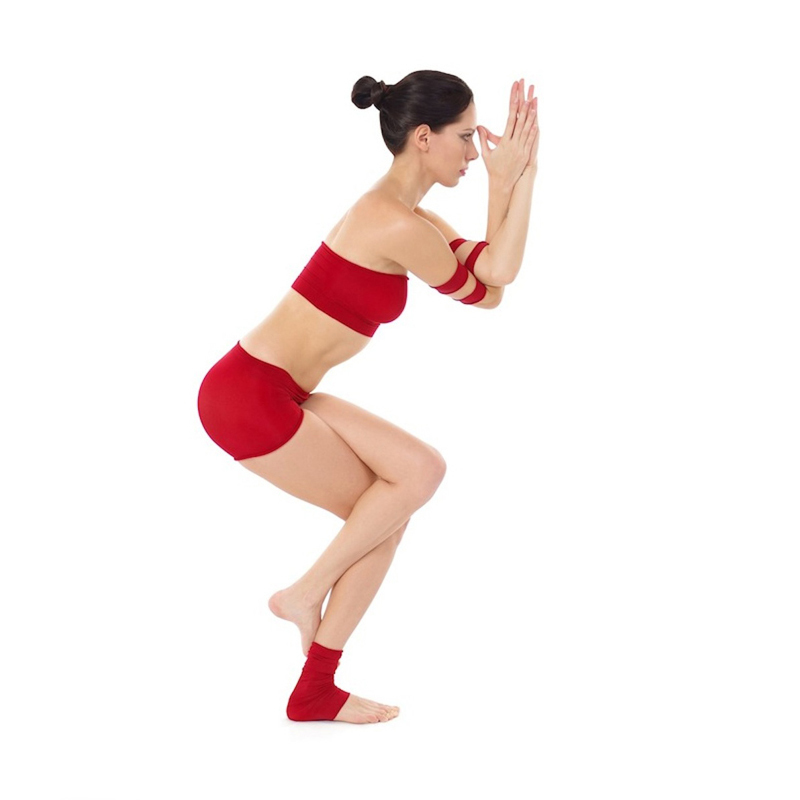Introduction
Garudasana which is known to us now is different from the pose that was originally described in the Seventeenth Century yoga text Gheranda Samhita.
Gheranda Samhita 1.37 describes
Place the legs and thighs on the ground pressing it, steady the body with two knees, and place the hands on the knees. This is Garudasana.
Verse 1.37 of Gheranda Samhita
From the above definition, we come to know that it is a sitting yoga position; whereas the modern Garudasana is a standing pose. However, the sitting posture is not in practice in any of the yoga schools. Hence, let us take the standing yoga posture for discussion here.
The modern pose was first described in the yoga book Lights On Yoga by B.K.S Iyengar in the year 1966. Sri Satyananda Saraswati of Bihar School of yoga described this pose in his book Asana Pranayama Mudra Bandha in the year 1969. However the nineteenth-century yoga text Sritattvanidhi describes a single-legged standing posture by this name.
From this information, we can easily deduce that the standing pose (apart from the pose described in Gheranda Samhita) has been in the traditional yoga practice. Therefore, it can aptly be called a traditional yoga pose rather than a modern yoga pose.
Garudasana Information
| Pose Name | Garudasana |
| Sanskrit | गरुडासन |
| IAST | Garuḍāsana |
| English | Eagle Pose |
| Origin | Traditional |
| Level | Intermediate |
| Group | Tadasana |
| Type | Asymetric Standing Pose |
Garudasana Meaning
गरुड़ासन is the combination of two Sanskrit words Garuda and Asana. Garuda is a legendary bird in Hindu, Jain, and Buddhistic mythology. It is an eagle-like bird and is the Vahana (vehicle mount) of Sri Vishnu, a deity in Hinduism.
In the final position of this posture, the hands look similar to the beak of Garuda. Hence this name. In English, we call it Eagle Pose.
Garudasana Procedure
Safety and Precautions
It is a position that warrants the balance of the body with standing on one leg. So pregnant ladies should avoid this pose because there is a risk of falling. Otherwise, it is pretty easy and risk-free.
Preparatory Poses
The following preparatory poses help to master Eagle Pose.
Garudasana Steps
Step 1
Stand upright on the floor.
Step 2
Next, bend the right leg and twist it around the left leg so that the right foot is on the calf of the left leg and the right thigh is on the front of the left thigh.
Step 3
Bend the elbows and bring them afront. Place the left elbow on the upper side of the right arm. Simultaneously press the palms together bring them closer to the face.
Step 4
Now slightly bend the left leg and lower the body. Focus the eyesight on the tips of the fingers. Breathe normally. Prolong the position as long as it is comfortable.
Step 4
Release the position and come back to normal standing Pose. Then repeat the steps by placing legs the other way around. Change the hands too.
Duration
The duration in the final position may be up to two to three minutes. Newbies could not extend the duration to that long. Hence they may repeat the process for three to five rounds. Once got the mastery, they could extend the duration to the desired level in a single round.
Garudasana Benefits
The benefits of Garudasana are given below.
- It improves the flexibility of the arms and legs.
- Eagle Pose gives a good balance over the body as well as mind.
- It strengthens the muscles of the arms and legs.
- This pose tones up the nerves and loosens the joints of the arms and legs.
- It is good for lumbago, and sciatica.

